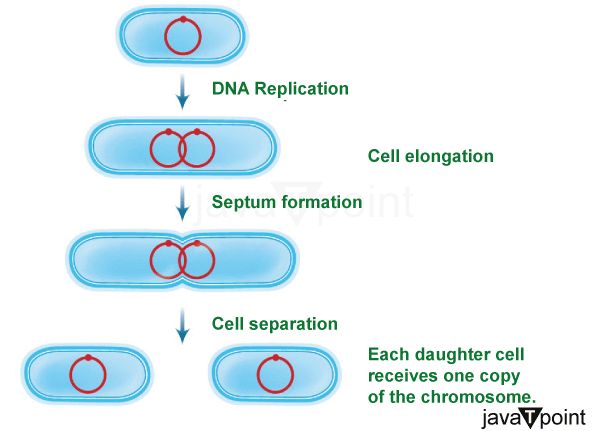Does Amitosis Occur in Bacteria
Amitosis, also known as direct cell division or binary fission, is the primary process of cell division in bacteria. Bacteria employ amitosis, a process that differs from the mitosis or meiosis that eukaryotic cells undergo, to reproduce and spread swiftly under various circumstances. The success of bacteria as a diversified and adaptable group of microorganisms can be attributed to the efficient method of amitosis, which enables bacteria to rapidly divide into two daughter cells and copy their genetic material.
Process of Amitosis (Binary Fission) in Bacteria
The process of binary fission, or amitosis, in bacteria involves a series of well-orchestrated steps:

- DNA Replication: The first step in binary fission is the replication of the bacterial genome. Often, all a bacteria needs to carry out its genetic makeup is a single circular chromosome. Bidirectional replication of this circular DNA molecule begins at a specific origin of replication on the chromosome.
- Cell Elongation: In order to accommodate the additional genetic material, the bacterial chromosome replicates more frequently, lengthening the cell. The freshly copied DNA is attached to specific sites on the cell membrane, which aids in separating the replicated chromosomes from the ensuing daughter cells.
- Septum Formation: Once DNA replication is complete, a septum or cell wall starts to form in the core of the elongated cell. The septum, a crucial component, separates the parent cell into two compartments, each storing a copy of the duplicated chromosome.
- Cell Division: As the septum growth progresses inward, the parent cell is completely separated into two daughter cells. Each daughter cell now has the replicated chromosome and a portion of the cellular components.
- Cell Separation: The two daughter cells split apart and grow into different organisms. The genetic makeup of both daughter cells has now undergone binary fission and is identical to that of the original parent cell.
Advantages of Amitosis (Binary Fission) in Bacteria
- Speed and Efficiency: Binary fission is a very efficient technique that bacteria use to increase their population in suitable environments rapidly. Since there is no intricate machinery or drawn-out procedure, bacterial cells can divide quickly and multiply exponentially.
- Energy Conservation: Binary fission is more energy-efficient than mitosis and meiosis in eukaryotes. Since bacteria usually inhabit environments with limited resources, their ability to divide quickly while conserving energy beneficial for their survival.
- Genetic Stability: Bacterial amitosis ensures genetic stability by evenly distributing the replicated DNA throughout the daughter cells. This stability is helpful in situations where genetic variations would not significantly benefit the situation.
- Survival in Harsh Environments: Bacteria are known for their ability to withstand extreme settings, which binary fission helps to explain. Because bacteria have an efficient and straightforward process for cell division, which ensures the survival of the species, they can reproduce even under challenging conditions.
Disadvantages of Amitosis
Here are the main disadvantages of amitosis in bacteria:
- Lack of Genetic Diversity: One of the main issues with amitosis in bacteria is the absence of genetic diversity among daughter cells. During binary fission, the paternal DNA is simply duplicated and divided evenly between the two daughter cells. Because of their genetic homogeneity, bacterial populations are unable to adapt to new environments, ward off predators, or evolve in response to changing conditions. A population without genetic diversity is more vulnerable to damaging environmental variables and is less likely to contain individuals with favourable traits that could aid in their survival and competitive success.
- Accumulation of Mutations: Errors in DNA replication that take place during the bacterial process of amitosis can lead to mutations. These mutations have the capacity to accumulate throughout generations and result in the loss of beneficial traits or the enhancement of harmful ones. Some mutations may be advantageous in specific situations, but the absence of meiotic mechanisms like recombination and independent assortment limits the capacity of advantageous mutations to propagate throughout the population.
- Susceptibility to Antibiotic Resistance: The absence of genetic variation in amitosis-affected bacterial communities makes them particularly susceptible to antibiotic resistance. Binary fission is a technique by which a single mutation in bacteria that confers antibiotic resistance can quickly propagate throughout the whole bacterial community. Because of the potential for the formation of superbugs that are challenging to treat with currently available drugs, this fast spread of antibiotic-resistant genes poses a severe threat to public health.
- Evolutionary Constraints: Bacterial populations have a limited capacity for evolution due to their low genetic diversity and the accumulation of mutations caused by amitosis. Through horizontal gene transfer (plasmids, for instance), bacteria largely exchange genetic material between individuals. Although less frequent, this sort of gene transfer is more typical than the genetic recombination found in sexual reproduction, which precludes the development of novel advantageous traits in bacterial populations.
- Vulnerability to Environmental Changes: It may be challenging for bacterial populations relying solely on amitosis to adapt to changing environmental conditions. In comparison to species that may engage in sexual reproduction or other types of genetic exchange, bacterial populations may be at a disadvantage in ecosystems that are experiencing rapid change due to a lack of genetic variation and a limited ability for evolution.
|

 For Videos Join Our Youtube Channel: Join Now
For Videos Join Our Youtube Channel: Join Now









